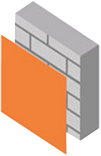Features
See allSurface preparation:
- Previously lime-washed or distempered surfaces must be thoroughly cleaned, scraped and wire-brushed
- Treat any fungus and algae with Berger Sterilizing Solution
- Treat chalking walls with Berger Alkali Sealer
- Treat efflorescence with Berger Alkali Sealer
Application Procedure:
- Application by brush, roller or spray
- Concrete/Cement - Stir very gently before application to avoid air bubbles. Apply Berger Concrete primer on new concrete
- For properties by the sea, apply 1 coat of Berger Alkali Sealer to new concrete surfaces
- New Wood: Apply Berger Wood Primer before applying Berger 303 Flat Emulsion
- Iron & Steel: Apply 1 coat Berger Zinc Chromate Metal primer before applying Berger 303
Tips: Berger 303 is great for both interior and exterior durability and hiding minor surface imperfections.
Tools you will need
Available Packs

1 Coat
9.0 m2/Ltr**
Coverage
On well-prepared surfaces, as per the painting system recommended. Please refer to the Product Data Sheet for surface preparation and method of application.
** Actual coverage may vary from the quoted coverage due to factors such as method and condition of application, surface roughness, and porosity.
Washability
- Best-in-class
- High
- Medium
- Low
Solve Potential Paint Problems
Chalking is the formation of a white, dusty powder on the paint film, and is actually a natural way for paint to breakdown as it weathers.
What are the possible causes?
- Long-term exposure of paint film to the elements
- Use of low-quality interior paint on an exterior surface
- Over thinning the paint
- Application of a thin paint film
- Failure to prime and seal the surface before applying topcoat
- Painting on a pre-existing chalky surface
What is the solution?
- Remove chalk residue using a stiff bristle or wire brush
- Wash with soap and water, and rinse thoroughly by hose or power washer
- Allow surface to dry and check for any remaining chalk by running a hand over the surface
- If noticeable chalk is still present, apply Berger Alkali Sealer or Berger Penetrating Liquid
- If no chalk is present, repaint as normal
- Repaint with a premium quality exterior coating
We recommend you use these painting systems in order of base coat, first coat, and second coat:
Poor hiding occurs when paint fails to obscure or hide the surface to which it is applied.
What are the possible causes?
- Using low-quality paint with little hiding power
- Spreading paint too thinly or unevenly
- Over-thinning paint beyond the recommended amount
- Failure to prime the surface before top-coating
- Painting a porous or absorbent surface
- Using incorrect or poor quality tools
- Inadequately mixed paint
What is the solution?
- Prime first, if moving from a significantly darker to a light colour
- When painting in a dark colour, tint primer in a similar tone to the topcoat shade
- Use premium quality paint for better hiding and flow
- Use quality and correct tools for the job
- Follow manufacturer's recommendation for thinning
We recommend you use these painting systems in order of base coat, first coat, and second coat:
-
Get Inspiration
-
Make Your Plan

Let us design a project plan to suit your needs.
-
Colour Tools












-can_8696.png)





-can_8696.png?width=82&height=102&mode=crop)









